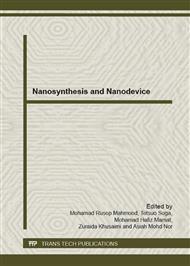p.186
p.193
p.200
p.206
p.213
p.218
p.224
p.231
p.240
Synthesis of Carbon Nanotubes by Chemical Vapour Deposition of Camphor Oil over Ferrocene and Aluminum Isopropoxide Catalyst
Abstract:
The aim of this study is to engage a basic understanding of the information carbon nanotubes (CNTs) may yield when this CNTs is deposited on silicon substrate over ferrocene and aluminum isopropoxide catalyst. Several popular methods are used to produce high quality CNT such as chemical vapour deposition, arc discharge and others. Most promising method is, chemical vapour deposition (CVD), used to produce CNTs in this experiment. The carbon source and catalyst were placed at different alumina boat in furnace one (1). The silicon substrate was placed at the deposition furnace and range temperature from 700 oC to 900 oC. The G-band peaks of the CNTs appear at round 1580 cm-1 and D-band peaks appear at 1348 cm-1. Thermal analyses show the percentage of CNTs weight loss 75.12%, 86.39%, 86.54%, 87% and 92.3% respectively. FESEM images was observed to study the formation of the CNTs. The CNTs were successfully synthesized from the chemical vapour deposition method.
Info:
Periodical:
Pages:
213-217
Citation:
Online since:
March 2013
Authors:
Price:
Сopyright:
© 2013 Trans Tech Publications Ltd. All Rights Reserved
Share:
Citation:


